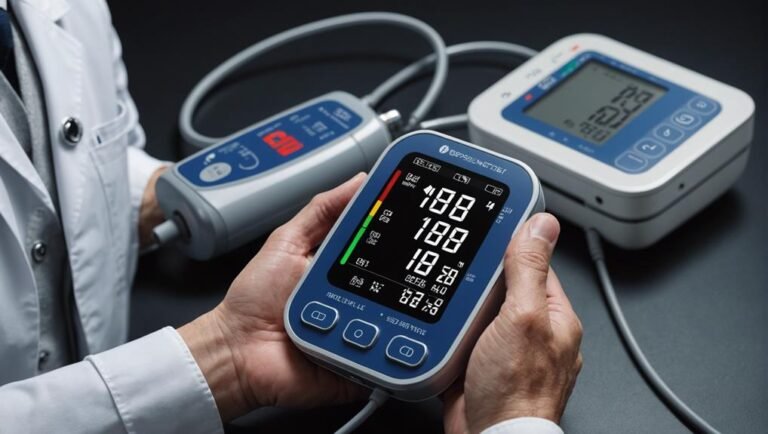Decline in Older Adults' Body Temperature Shock
As older adults age, their body temperature may decline, making them more vulnerable to temperature shock. Factors like age-related changes, medication effects, and reduced metabolic rate contribute to this decline. Lower body temperatures in older adults increase the risk of hypothermia. Understanding the signs of hypothermia like confusion and slurred speech is essential. Dressing warmly, maintaining a warm environment, and regular temperature monitoring are key preventive measures. By grasping the nuances of body temperature regulation in aging individuals, you can safeguard their health effectively. There's much more insight waiting to help you maintain the well-being of older adults.
Key Takeaways
- Older adults have lower baseline temperatures, increasing susceptibility to hypothermia.
- Age-related changes impact temperature regulation, leading to temperature fluctuations.
- Medications and reduced metabolic rate in older adults contribute to lower body temperature.
- Thinning skin and decreased ability to shiver affect older adults' temperature control.
- Monitoring body temperature changes is crucial for early identification and preventive measures against hypothermia.
Understanding Normal Body Temperature Range
Understanding the typical range of body temperature is essential for evaluating health and detecting potential issues in older adults. As individuals age, temperature fluctuations become more common due to changes in the body's ability to regulate heat.
Older adults may experience lower baseline temperatures, making them more susceptible to hypothermia, especially during seasonal variations in body heat. It's important to monitor these fluctuations carefully to prevent any adverse health effects.
Being aware of these variations can help in identifying warning signs early on and taking necessary precautions to maintain the best body temperature. By staying informed and attentive to these changes, you can better safeguard your health and well-being as you age.
Factors Contributing to Lower Body Temperature
Lower body temperature in older adults can be influenced by a variety of factors such as age-related physiological changes, medication usage, and underlying health conditions. As individuals age, their bodies undergo various transformations that can impact how they regulate temperature. Additionally, certain medications can alter normal bodily functions, including temperature control. Here is a table summarizing key factors contributing to lower body temperature in older adults:
| Factors Contributing to Lower Body Temperature |
|---|
| Age Related Changes |
| – Decreased metabolic rate |
| – Reduced ability to shiver |
| – Thinning of the skin |
| Medication Effects |
| – Blood pressure medications |
| – Psychiatric drugs |
| – Opioids |
Risks of Hypothermia in Older Adults
As older adults face lower body temperatures due to various factors, it's important to be aware of the heightened risks of hypothermia in this population. Hypothermia awareness is critical as older individuals have a decreased ability to regulate their body temperature efficiently.
Changes in temperature regulation due to aging, medications, or underlying health conditions make seniors more vulnerable to hypothermia, especially in cold environments. Recognizing the signs of hypothermia, such as shivering, confusion, and slurred speech, and taking prompt action if you suspect someone is affected is crucial.
Preventing prolonged exposure to cold, dressing warmly, and keeping living spaces adequately heated are essential strategies to reduce the risk of hypothermia in older adults. Stay vigilant and prioritize maintaining a safe and comfortable temperature to safeguard against this potentially dangerous condition.
Preventative Measures Against Hypothermia
To effectively protect older adults from the risks of hypothermia, prioritize maintaining a warm and comfortable environment in their living spaces. Make sure that their homes are adequately heated, especially during colder months, and encourage the use of appropriate winter clothing such as warm layers, hats, gloves, and socks to help retain body heat.
Set the room temperature to a comfortable level, typically between 68-70 degrees Fahrenheit, to prevent chilling. Check heating systems regularly to confirm they're functioning efficiently. Additionally, consider using blankets or heating pads to keep warm while sitting or resting.
Importance of Monitoring Body Temperature
Monitoring body temperature is vital for evaluating health status and detecting potential issues in older adults. As individuals age, changes in thermoregulation can impact how the body maintains a stable internal temperature.
Using accurate temperature monitoring techniques, such as digital thermometers or infrared ear thermometers, can provide valuable insights into an older adult's well-being. Understanding thermoregulation in aging is important, as older adults may have a decreased ability to regulate their body temperature efficiently, making them more vulnerable to temperature-related complications.
Conclusion
As you navigate the changes in your body temperature as you age, remember that staying vigilant and proactive is key to maintaining your health and well-being.
By monitoring your body temperature regularly and taking preventative measures against hypothermia, you can protect yourself from potential risks.
Remember, knowledge is power, and being informed about these changes can make all the difference in your journey towards peak health.
Stay tuned for more insights and tips on how to care for your body as you age.







